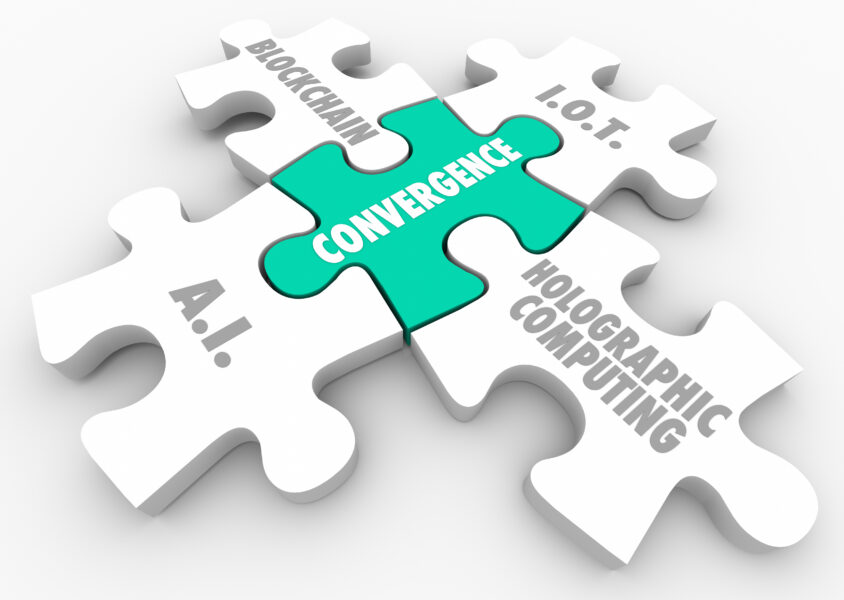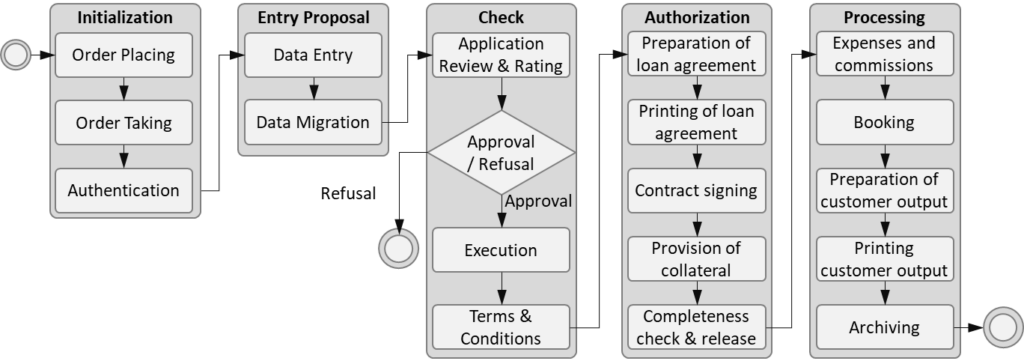
The Convergence of Distributed Ledger Technology and Artificial Intelligence Exemplified by the Lending Process (Part 3)
In the first two contributions to this three-part series, we have shown that the simultaneous use of distributed ledger technology and artificial intelligence can improve today’s lending process in many ways. However, the lending process is only one of many processes that can potentially benefit from the merging of DLT and AI. In the following we have compiled the process characteristics that indicate that a process leads to the convergence of the two technologies and can therefore be optimized by them.
Basic premises for the convergence of DLT and AI in the lending process
Overall, it can be seen that almost every single sub-process in Figure 1 has at least one weakness and leaves room for technology-supported improvements.

The reference process is very time-consuming, especially the data processing and credit approval itself. Since AI, in contrast to DLT, is traditionally driven by centralized infrastructures, the two technologies complement each other not only within individual sub-processes, but above all across individual subtasks and thus converge across sub-processes. DLT enables consistent data storage for reliable processing by AI. The DLT alone has no effect on application review and evaluation, but serves to store the output generated by the AI and makes parts of the data available for the next sub-process. Subsequently, we were able to derive four basic premises for convergent application of the technologies:
- The use of sensitive data promotes general DLT-AI convergence
“Data sensitivity” refers to processed information that must be protected from unauthorized access. Processes involving sensitive data indicate the convergence of DLT and Cognitive Engagement or Predictive Analytics, as CE and PA can provide valuable insights and predictions based on the sensitive data stored on the DLT. The convergence of DLT and AI could unlock the full potential of sensitive data in customer-related services while maintaining a high standard of data protection. As all parties authorized to access the data through the DLT work with a uniform database, prevailing data silos and information asymmetries can be reduced. The convergence of DLT and Robotic Process Automation is achieved by adding the safe, rule-based processing by RPA to the safe, transparent data storage by the DLT, resulting in a reliable process. - Media breaks support DLT-RPA and DLT-CE convergence
Media breaks between sub-processes are a signal for the convergence of DLT and AI application types that are not intended to predict future events, such as RPA and CE. This convergence is mainly due to the problems associated with media breaks, such as loss of information or information inconsistency caused by incorrectly transmitted or inconsistent data sets. While the former problem can be solved by DLT due to its architectural characteristics, the latter can be optimized by RPA or CE application types. RPA avoids media discontinuity through the digitalization of previously manual process steps, as in the case of an automated credit check, while CE can convert input data from the physical world directly into a digital format without the need for manual data entry by a customer advisor. - A high degree of standardization and low data variability promote DLT-RPA convergence
“Data variability” means the number and types of input data involved in a process. Since the actions that an RPA application or smart contract can perform must be programmed in advance and follow an “if-then” logic, these two applications depend on a high degree of standardization and specification. Conversely, repetitive tasks imply an application potential of DLT and RPA, especially for increasing transparency in the processing of sensitive data. - A high degree of standardization and high data variability promote DLT-CE and DLT-PA convergence
Unlike DLT-RPA convergence, high data variability promotes DLT convergence with both CE and PA. This is due to the fact that the tamper resistance of the DLT increases the confidence in the data input as well as in the result of the interpretation of CE and PA applications. For example, the confidence in reporting and monitoring can be increased. The decisions made on the basis of the information obtained become more robust.
Indeed, the convergence of both technologies has proven to be a further step towards intelligent automation and digitalization of services. Sub-processes are much more integrated through the use of DLT and AI, resulting in fewer manual tasks and greater efficiency within the lending process. The convergence of the two technologies can promote integration between the physical and digital worlds and also open up new markets, as in the case of Internet-based services in the form of e-commerce, which combines, among other things, the Internet, mobile technology and various hardware technologies (Lei, 2000). Therefore, the convergence of DLT and AI could accelerate the digitalization of service delivery and, especially in the context of the Internet of Things, move many administrative processes, such as authentication and information transmission, into the background in such a way that innovative services emerge within new technology-based ecosystems. Car sharing, in which the user only has to get into the car and all administration (authentication, payment, insurance) runs unnoticed in the background, is only a first glimpse of the possibilities that such convergence could create in the future.
Sources:
Alt, R. and Puschmann T. (2016). Digitalisierung der Finanzindustrie. Berlin/Heidelberg: Springer
Lei, D. T. (2000). “Industry evolution and competence development: the imperatives of technologi-cal convergence.” International Journal of Technology Management 19 (7–8), 699–738.
